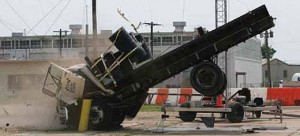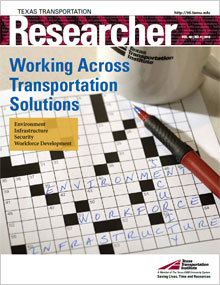“9/11 changed everything.”
Nearly a decade after the deadliest foreign attack on American soil in our nation’s history, that phrase is almost a cliche. Unfortunately, that doesn’t make it any less true.
In medieval times, the main gate, or portcullis, was the most important part of a castle’s security. If the gate was breeched, enemy forces would pour in.
“While our technology has become more sophisticated, the basic strategy for defense hasn’t changed,” explains Texas Transportation Institute (TTI) Assistant Agency Director Dean Alberson, who manages TTI‘s Crashworthy Structures Program. “Keeping an enemy from getting close enough to do harm is still the best way to ensure the safety of U.S. citizens, both at home and abroad.”
Protecting Our National Assets
To that end, in August 2010, the U.S. Department of State’s Bureau of Diplomatic Security awarded TTI a contract for up to $7 million over a five-year period to design, analyze and test perimeter security devices. TTI began work with the State Department in 2002, conducting dozens of tests intended to increase security for American embassies and other posts around the globe.

The first project under the new contract involves crashing various vehicles into an instrumented pier designed to measure the impact of the collisions. These tests will help researchers design various future devices that will meet U.S. security standards.
The State Department’s 2003 anti-ram barrier standard, which limited barrier penetration to 3 feet, acknowledged the “tight quarters” reality of embassy placements but didn’t address some of the needs of military bases, which are typically surrounded by wide-open spaces. The more space between buildings, the longer the stopping distance needed to prevent enemy vehicles from getting too close. The safety of building occupants is enhanced with every foot of space between the facility and a terrorist’s bomb. The 2003 standard also assumed a 2.5-ton diesel truck as the method for bomb delivery, whereas recent experiences in Iraq, Afghanistan and other countries make it clear that practically any vehicle will do for delivering destruction.
Acknowledging this reality, the U.S. Army Corps of Engineers demanded a more flexible standard, so ASTM International created a working group, chaired by Alberson, to develop it. The new ASTM F2656-07 Standard Test Method for Vehicle Crash Testing of Perimeter Barriers adds more penetration ratings, incorporates design flexibility to cover a wider range of vehicles, and specifies different impact velocities for some vehicle categories. The State Department officially adopted this standard in October 2008.
Speaking of security concerns around the world, the United Kingdom’s Center for the Protection of National Infrastructure has contracted with TTI to help translate between U.K. and U.S. standards. The British version of ASTM F2656-07 is called BSI PAS 68, but its requirements don’t match up exactly with its American counterpart.
“TTI‘s job is to help harmonize the testing for these two standards,” says Alberson. “Making them more compatible will improve structural defense by limiting the opportunity for confusion or miscommunication among those trying to use them.”
Securing Our Borders
TTI researchers have completed two projects with the National Center for Border Security and Immigration, funded through the Department of Homeland Security’s Center of Research Excellence Program, to assess and improve security at the U.S.-Mexico border. One project analyzed technology and processes at land ports of entry (POEs), and the second one analyzed how technology can be used to improve security at land POEs. Technology, layout and process need to be coordinated, so the second phase of the project identified improvements that could be implemented to further increase security at POEs.
“It’s a tricky thing to balance security with the need to keep things moving,” explains TTI Research Scientist Juan Villa, currently managing TTI‘s Mexico City office. “There are trade-offs to be evaluated, including safety, efficiency and economic considerations, not to mention right to privacy.”
Hazardous Materials Tracking
Transport of hazardous materials has both security and freight safety concerns. Terrorists, for example, might try to conduct a catastrophic attack using a planned release of hazardous materials. Transportation accidents can also expose people and the environment to these materials.
TTI will soon be working with Texas Southern University to validate new tools for measuring and tracking hazmat movements on Houston’s industrial corridors. The Institute has also worked with the Texas Division of Emergency Management and Texas counties to evaluate hazmat movements. TTI and Texas A&M University’s Hazard Reduction and Recovery Center researchers have co-authored a hazmat commodity flow study guidebook to be published by the Transportation Research Board in 2011.
TTI Research Specialist Debbie Jasek and Associate Research Scientist David Bierling explain that these studies are different from a lot of traditional traffic evaluations. “TTI works with community officials and volunteers to figure out where, when and how hazmat is transported. We can also help evaluate their chemical transport risks,” says Bierling.


